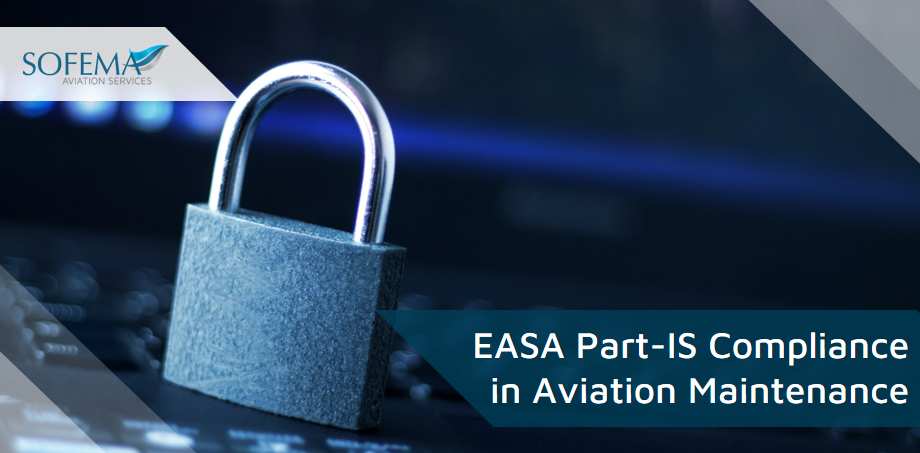Sofema Online (SOL) considers key challenges related to EASA Part-IS Compliance in Aviation Maintenance
Introduction – EASA’s Part-IS compliance is essential to protect aviation maintenance operations from cybersecurity threats. However, organizations must strike a balance between security measures and operational efficiency. By adopting a risk-based approach, improving cyber awareness training, leveraging secure digital solutions, and ensuring robust supply chain security, aviation maintenance providers can maintain compliance while avoiding disruptions to maintenance workflows.
The implementation of EASA Part-IS (Information Security) compliance presents several challenges, particularly in the aviation maintenance sector, where security must be balanced with operational efficiency. Below are some of the key challenges organizations face:
Integration with Existing Regulatory Frameworks
- Many aviation maintenance organizations already comply with EASA Part-145 (Maintenance Organizations), Part-CAMO (Continuing Airworthiness), and Part-21 (Design & Production). Ensuring that Part-IS requirements align with existing frameworks without causing regulatory overlap or operational confusion is a challenge.
Complexity of Supply Chain Cybersecurity
- Maintenance, Repair, and Overhaul (MRO) organizations depend heavily on external suppliers, Original Equipment Manufacturers (OEMs), and IT service providers. Ensuring cybersecurity compliance across all stakeholders can be difficult, particularly when third-party systems and remote maintenance monitoring are involved.
Legacy Systems and Digitalization Risks
- Many aviation maintenance organizations still use legacy IT systems that were not designed with cybersecurity in mind.
- The push toward digital transformation (e.g., predictive maintenance, cloud-based CAMO/MRO solutions) increases vulnerability to cyber threats.
Balancing Security with Operational Efficiency
- Cybersecurity measures (e.g., multi-factor authentication, restricted access to digital maintenance records) can slow down daily operations.
- Maintenance teams require quick access to aircraft systems and technical documentation. Overly restrictive security protocols can disrupt maintenance workflows.
Human Factor & Cyber Awareness Training
- Many cybersecurity incidents are caused by human error or lack of awareness.
- Maintenance personnel often focus on physical security and compliance with EASA Part-145 safety requirements, but may underestimate cybersecurity risks such as phishing attacks or unauthorized system access.
Threat Detection & Incident Response Challenges
- Cyber threats evolve rapidly, making it difficult to maintain real-time threat detection.
- Organizations need an effective incident response plan that complies with EASA’s reporting requirements, yet many lack the necessary technical expertise and resources to do so efficiently.
Balancing Security Requirements with Operational Efficiency
Organizations can achieve an effective balance between cybersecurity and operational efficiency by implementing the following best practices:
Risk-Based Approach to Cybersecurity
- Apply a risk management framework to categorize systems based on their impact on safety and operations.
- Prioritize critical assets (e.g., electronic maintenance records, remote access systems) while allowing more flexibility in non-critical areas.
Adaptive Cybersecurity Measures
- Implement role-based access controls (RBAC) to ensure that only authorized personnel have access to sensitive systems.
- Use automated monitoring tools to detect anomalies without disrupting maintenance tasks.
Cybersecurity Training for Maintenance Personnel
- Introduce tailored cybersecurity training for MRO staff, covering topics like:
- Recognizing phishing attacks
- Safe use of USB devices in maintenance laptops
- Best practices for handling aircraft maintenance data securely
Secure Digital Maintenance & Documentation
- Shift from paper-based records to secure, encrypted digital platforms with real-time access logs.
- Implement Blockchain technology for aircraft maintenance records to prevent tampering.
Incident Response & Business Continuity Planning
- Develop a cybersecurity incident response plan that aligns with EASA Part-IS reporting requirements.
- Establish redundant systems and data backups to ensure operational continuity in case of a cyber incident.
Stronger Supply Chain Cybersecurity Policies
- Require cybersecurity compliance checks for third-party vendors.
- Ensure that suppliers follow secure software update protocols to prevent cyber risks from infiltrating aircraft maintenance systems.
Next Steps
- Follow this link to our Library to find & download related documents for Free.
- See the following 2-day course- Part 145 Cyber Security Implementation. For comments or questions, please email team@sassofia.com.
Tags:
Aviation Maintenance, EASA Part 145, Part CAMO, SAS blogs, EASA Part IS, Cybersecurity, Maintenance organizations, EASA Part-IS Compliance, Existing Regulatory Frameworks, Maintenance Personnel, Secure Digital Maintenance





